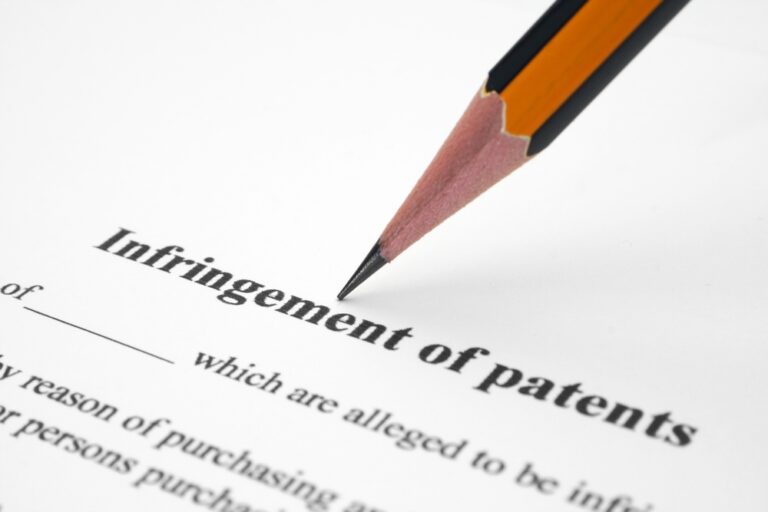Understanding Patent Infringement
In the realm of intellectual property, securing a patent is a significant step towards safeguarding your invention. However, the journey doesn’t end here. The threat of patent infringement is a serious concern for inventors and businesses alike. This article explores the sphere of patent infringement, shedding light on its various facets including the patent infringement definition, types, and procedures involved in addressing infringement issues. Recognizing an early infringement can be the key to resolving disputes amicably and cost-effectively.
It is important that you work with a legal team to ensure you retain your rights if your patent is being infringed upon. At Gearhart Law, we believe in keeping the patent process easy and simple for our clients. Call one of our experienced patent attorneys at 908-273-0700 today for more information.

Defining Patent Infringement
Patent infringement occurs when a third party makes, uses, sells, or offers to sell a patented invention without the patent holder’s permission. The specifics of what constitutes infringement can vary, but the essence remains the encroachment upon the patent holder’s exclusive rights.
Common Misconceptions
Many assume that having a patent in one country provides global protection, which is far from the truth. Patent rights are territorial and enforced by the respective country’s laws.
Types of Patent Infringement
Direct Infringement
This is the unauthorized practice of any patented invention within a country where the patent is held.
Indirect Infringement
This involves contributing to or inducing the infringement of a patent.
Literal and Doctrine of Equivalents Infringement
Literal infringement happens when the accused product or process falls within the patent claim. Doctrine of equivalents infringement occurs when the accused product or process performs substantially the same function in substantially the same way to obtain the same result.
Navigating Patent Infringement Lawsuits
Seeking Legal Advice
Engaging a patent attorney or a patent infringement lawyer is crucial when facing a potential infringement scenario.
Issuing a Cease and Desist
A patent infringement cease and desist letter is often the first step towards resolving an infringement issue.
Filing a Lawsuit
If a cease and desist doesn’t resolve the issue, filing a patent infringement lawsuit might be the next step.
Proving Patent Infringement
Collecting Evidence
Gathering evidence of patent infringement is a cornerstone of building a robust case.
Demonstrating Claim Scope
Proving that the accused infringer has fallen within the scope of at least one claim of the patent is crucial.
The Role of a Patent Infringement Claim Lawyer
Assessment and Representation
A patent infringement claim lawyer assesses the case, represents you in court, and navigates the complex litigation landscape.
Negotiating Settlements
They can also assist in negotiating settlements or licensing agreements outside court, often saving time and resources.
Mitigating Risks and Regular Monitoring
Regular monitoring of the market for potential infringements is a proactive measure to safeguard your patent rights. A patent lawyer can help you do this.
Patent Insurance
Patent insurance can provide financial protection against the costs associated with defending a patent.
FAQs
1. What triggers a patent infringement lawsuit?
A patent infringement lawsuit is triggered when a patented invention is made, used, sold, or offered for sale without the patent holder’s permission within the country the patent is held.
2. What is the role of a patent lawyer?
A patent lawyer provides legal advice, represents you in court, and helps navigate through the complex legal landscape surrounding patent laws and infringement disputes.
3. How can one defend against a patent infringement claim?
Defenses against patent infringement claims include proving that the patent is invalid, showing that no infringement occurred, or arguing that the patentee is estopped from asserting infringement due to misleading conduct.
4. What are the potential outcomes of a patent infringement lawsuit?
Outcomes can range from court-ordered injunctions, monetary damages, attorney fees, to settlement agreements or licensing agreements.
5. What steps can be taken to prevent patent infringement?
Steps include regularly monitoring the market and consulting a patent lawyer. It is important you do this. A patent lawyer can help. Patent lawyers can help you overcome obstacles and mitigate the risks over a patent you have worked very hard to obtain.
Choosing a Patent Lawyer to Protect Your Patent
At Gearhart Law, we believe in protection our client’s patents. To consult our knowledgeable attorneys, call us at 908-273-0700 for your free consultation.
The content herein is meant to be educational only and not to substitute for legal advice. If you have a legal question please consult an attorney.
*Powered by AI


